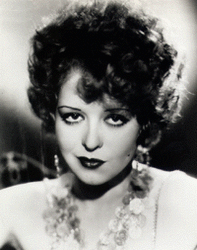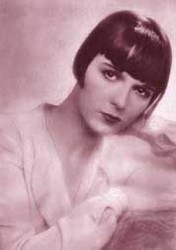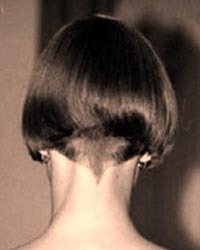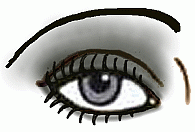Flaming Youth; Flappers and Cake Eaters
They redefined the meaning of the word "woman"...
What was a flapper? A flapper was a young woman in the 20's, who "flaunted her 'unconventional' conduct and dress," shocking her parents and indeed the entire older generation. A cake eater, on the other hand, was a "boy flapper," a guy who wowed the flappers. As the 1922 song "I'm a Cake Eating Man" stated;
"I'm a cake-eating man,/ Eat my cake where I can;/ I like a dapper flapper that shows a naughty knee,/ Who dances naughty jazz and shakes a naughty lingerie./ I'm there with my shoe-polish hair,/ For I'm a mama-loving, cookie-chewing cake-eating man."
A staple of the flappers was their hair. Doing away with her long Victorian locks for convenience, the first woman to "bob" her hair was the celebrated ballroom dancer Irene Castle, in 1915. Named after her, the Castle Bob triggered a dramatic change in the way women wore their hair, forever.
"I'm a cake-eating man,/ Eat my cake where I can;/ I like a dapper flapper that shows a naughty knee,/ Who dances naughty jazz and shakes a naughty lingerie./ I'm there with my shoe-polish hair,/ For I'm a mama-loving, cookie-chewing cake-eating man."
A staple of the flappers was their hair. Doing away with her long Victorian locks for convenience, the first woman to "bob" her hair was the celebrated ballroom dancer Irene Castle, in 1915. Named after her, the Castle Bob triggered a dramatic change in the way women wore their hair, forever.
Women grew bolder with their hair cut short. A saying put it like this: soon they began wearing “long beads, short skirts, rolled stockings, and rough [makeup] on her knees.” The new hair bob also gave way to new curling, perming, and coloring methods.

Then came the short story "Bernice Bobs Her Hair" by F. Scott Fitzgerald, published in the Saturday Evening Post on May 1st, 1920. It was a story of how a girl, Bernice, was sweet (but dull) until she bobbed her hair, and was transformed into a “smooth-talking vamp” by her cousin. Bernice soon became a role model for many young women, who now faced a serious decision -- whether to bob or not to bob.
Celebrities also helped spread the bob. Actresses such as Clara Bow and Louise Brooks and lead fashion designer Gabrielle Bonheur “Coco” Chanel all led women to the barber to take the plunge. Some women even saved their old locks of hair to use as hair extensions to cover up their new cut. Overseas, meanwhile, Queen Mary preferred that if a woman had short hair, that she hide it at court functions or royal ceremonies. King George took no official position to the growing controversy.
Eventually more sophisticated bob styles began to appear. The shingle bob was introduced in 1923, and other women chose the waved style. There was also the "Dutch Boy" hairstyle (Louise Brooks was known as "the girl in the black helmet"), and the Eton Crop, named after a British boy's prep school. But the controversy lasted up until 1927, when women started experimenting with softer, more feminine looks.
Celebrities also helped spread the bob. Actresses such as Clara Bow and Louise Brooks and lead fashion designer Gabrielle Bonheur “Coco” Chanel all led women to the barber to take the plunge. Some women even saved their old locks of hair to use as hair extensions to cover up their new cut. Overseas, meanwhile, Queen Mary preferred that if a woman had short hair, that she hide it at court functions or royal ceremonies. King George took no official position to the growing controversy.
Eventually more sophisticated bob styles began to appear. The shingle bob was introduced in 1923, and other women chose the waved style. There was also the "Dutch Boy" hairstyle (Louise Brooks was known as "the girl in the black helmet"), and the Eton Crop, named after a British boy's prep school. But the controversy lasted up until 1927, when women started experimenting with softer, more feminine looks.
Clara Bow Louise Brooks the Shingle or "boyish" bob
Bobbed hair led to the invention of something we still use today -- the bobby pin. It also led to the beauty industry becoming much greater. There was also a new medical term coined from bobbed hair. The “shingle headache” was said to be caused by getting the shingle bob and exposing the tender nape of the neck to “blustery winds.” They said it was a form of neuralgia, or nerve pain.
A guy's hair in the 1920's was also important. If they weren't wearing bowler hats, such as the kind inspired by Charlie Chaplin, then they parted their hair, often in the middle, and slicked it close to their head with hair products to create a black, polished look. Cuts tended to be a bit long on the tops and sides (and occasionally in the back) but short and shaved at the nape. Short, simple, and neat, parting their hair on the side was considered an "outrageous fashion statement."
Flappers were the icon of the 1920’s. Although they weren’t the majority of the population, they played a very important role in the new fun-loving society. This was the first time that the fashions and attitudes of a younger generation were copied by the older, although in moderation.
Something else distinctive about the 20's flappers was their makeup. They had richly ringed eyes and red cupid-bows lips, as well as bright red fingernails. They also put makeup on their knees. With the new knee-revealing clothes, their knees were now visible, especially to men. They wanted their knees to look good, and not show any imperfections from their childhood exploits. Many parents reacted badly to their daughters wearing makeup. Every girl wanted to be a flapper, and makeup, as well as bobbed hair, was the way to do it. But according to some parents, makeup was "paint" that wasn't to be worn.
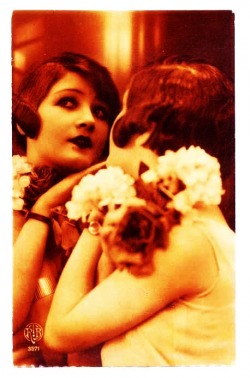
Before the 1920's, makeup was not socially "proper" for young girls and women to wear. It had really been only prostitutes who wore makeup prior to the 20's, and if it was worn at all, it was concealed. But the whole attitude towards makeup changed in this era. Harmful substances such as mercury, lead, and sulfur were removed from most products, and new colors came to market.
Eyes in the 1920's were dark and dramatic. The eyelids were covered with dark eyeshadow, often gray, turquoise, or green, and kohl was applied all around the eye and smudged outwards. However, back then kohl was a mixture of soot, lead, and goose fat. There was also mascara, but it came in block form, and had to be heated up and applied with a wand or stick. False eyelashes were also used, styled with mascara. Thin, black, and downward- sloping eyebrows were popular. They were often inked with a black or brown Egyptian eyeliner (kohl).
Face powder had been used before the 1920's, but then it had been pale and pasty. But in the twenties it became more acceptable to be outdoors, so colors became more natural rather than the pale and subdued whites or ivories. It was said that when Coco Channel fell asleep in the sun, tanning became an instant fad. But the cream or ivory face powder was still used by most women in the early 20's.
Blush was known as "rouge" in the 20's, and came in many forms, from powder to cream, and some women even used papers to add the cheek color. The powder form eventually became most popular, and by the middle of the decade orange was the most popular color of rouge, although other popular colors were rose or raspberry. The rouge was put on the cheeks with a brush but wasn't blended, leaving a visible circle and lending an almost doll-like appearance. But if a girl wasn't allowed to wear rouge, she would pinch her cheeks for color.
The lips were an integral part of the 1920's flapper look. They were bright red (red was the only color available, and came in a few different shades), and some women lined their lips with liquid rouge for a more dramatic effect and so that they could re-draw the shape as needed. In the mid-twenties, lips were deep red, deep brownish reds, plum, and orange. In the late twenties colors like rose, raspberry, and medium red were new trends. Lipstick was taken slightly beyond the natural lip line with each lip, and in the early 20's the lips weren't colored in the corners of the mouth, but stopped suddenly. 1920's makeup was all about the effect -- the more dramatic, the better. In the late 1920's, however, lips were colored in the corners, and the color on the top lip was taken even more beyond the lip line on either side of the "cupid's bow" in the middle. The middle of the top lip was left slightly uncolored, giving a sort of split-in-half look. 1920's flapper lips were called Cupids' Bow or Armor's Bow lips.
Eyes in the 1920's were dark and dramatic. The eyelids were covered with dark eyeshadow, often gray, turquoise, or green, and kohl was applied all around the eye and smudged outwards. However, back then kohl was a mixture of soot, lead, and goose fat. There was also mascara, but it came in block form, and had to be heated up and applied with a wand or stick. False eyelashes were also used, styled with mascara. Thin, black, and downward- sloping eyebrows were popular. They were often inked with a black or brown Egyptian eyeliner (kohl).
Face powder had been used before the 1920's, but then it had been pale and pasty. But in the twenties it became more acceptable to be outdoors, so colors became more natural rather than the pale and subdued whites or ivories. It was said that when Coco Channel fell asleep in the sun, tanning became an instant fad. But the cream or ivory face powder was still used by most women in the early 20's.
Blush was known as "rouge" in the 20's, and came in many forms, from powder to cream, and some women even used papers to add the cheek color. The powder form eventually became most popular, and by the middle of the decade orange was the most popular color of rouge, although other popular colors were rose or raspberry. The rouge was put on the cheeks with a brush but wasn't blended, leaving a visible circle and lending an almost doll-like appearance. But if a girl wasn't allowed to wear rouge, she would pinch her cheeks for color.
The lips were an integral part of the 1920's flapper look. They were bright red (red was the only color available, and came in a few different shades), and some women lined their lips with liquid rouge for a more dramatic effect and so that they could re-draw the shape as needed. In the mid-twenties, lips were deep red, deep brownish reds, plum, and orange. In the late twenties colors like rose, raspberry, and medium red were new trends. Lipstick was taken slightly beyond the natural lip line with each lip, and in the early 20's the lips weren't colored in the corners of the mouth, but stopped suddenly. 1920's makeup was all about the effect -- the more dramatic, the better. In the late 1920's, however, lips were colored in the corners, and the color on the top lip was taken even more beyond the lip line on either side of the "cupid's bow" in the middle. The middle of the top lip was left slightly uncolored, giving a sort of split-in-half look. 1920's flapper lips were called Cupids' Bow or Armor's Bow lips.
Fingernails were also an important part of the flapper look. They were most often red or some shade of that, and were painted only in the center. The half-moon and the tip were left bare and white.
Flappers were bold. They were daring and dramatic, all about expression and individuality. Although most women weren't flappers, the ones who were set the tone for the country and for indeed the entire era. Their "shocking" behavior let other women explore the new freedoms of the age without fear. Rebellious and fun-loving, they were a product of the new 1920's urban America. They literally created a new meaning of the word "woman."
For the first time in history it was okay for women to smoke and drink in public. This generation of women wasn't as concerned about women's voting rights as the older generation was. They wanted equality but wanted fun at the same time. And if getting that meant changing the world's perspective on how women were supposed to behave, then that's exactly what they'd do. Flappers hung out at nightclubs and speakeasies. They expected to go out with a few different men before settling down for marriage. Flapper fashion was said to be born on a cool day in France when Coco Chanel put on an oversized man's sweater and tied the waist with a scarf, and the Chanel frock was born. Flappers definitely weren't afraid to speak their minds. If it weren't for these 1920's-flappers, who knows how women would be regarded nowadays? They shocked the entire world, creating an entirely new generation of women.
Flappers were bold. They were daring and dramatic, all about expression and individuality. Although most women weren't flappers, the ones who were set the tone for the country and for indeed the entire era. Their "shocking" behavior let other women explore the new freedoms of the age without fear. Rebellious and fun-loving, they were a product of the new 1920's urban America. They literally created a new meaning of the word "woman."
For the first time in history it was okay for women to smoke and drink in public. This generation of women wasn't as concerned about women's voting rights as the older generation was. They wanted equality but wanted fun at the same time. And if getting that meant changing the world's perspective on how women were supposed to behave, then that's exactly what they'd do. Flappers hung out at nightclubs and speakeasies. They expected to go out with a few different men before settling down for marriage. Flapper fashion was said to be born on a cool day in France when Coco Chanel put on an oversized man's sweater and tied the waist with a scarf, and the Chanel frock was born. Flappers definitely weren't afraid to speak their minds. If it weren't for these 1920's-flappers, who knows how women would be regarded nowadays? They shocked the entire world, creating an entirely new generation of women.
These women (see right) were beloved icons of the era, and made the 20's their era, with practically everything they did. They set the fads and fashions for everyone else, and everyone knew their face when they saw it.
Famous flappers include: Clara Bow, Josephine Baker, Louise Brooks, Madge Bellamy, Marie Prevost, Laura La Plante, Alice White, Anita Page, Bebe Daniels, Lupe Velez, Helen Kane, Betty Compson, Coleen Moore, Joan Crawford, Bee Jackson, the Sisters "G" (Eleanor and Karla Gutchrlein), Evelyn Brent, Phyllis Haver, Mary Pickford, Nancy Caroll, and Lila Lee.
Cake Eaters, although not as famous, were the male companion to the 1920's flapper. With their slicked hair and smooth-talking, they hung around speakeasies, hoping to get both a drink and a girl. Or they'd hang around in their "sweetie's" house, waiting to be pampered and often eating what his girl baked.
There were also many new slang words introduced in the 1920's. This was the first age that emphasized youth culture over the tastes of the older generations. Flappers and their sub-culture had great influence over the whole of America, and coined many new phrases, some which we still use today. Some of these words/phrases were:
Famous flappers include: Clara Bow, Josephine Baker, Louise Brooks, Madge Bellamy, Marie Prevost, Laura La Plante, Alice White, Anita Page, Bebe Daniels, Lupe Velez, Helen Kane, Betty Compson, Coleen Moore, Joan Crawford, Bee Jackson, the Sisters "G" (Eleanor and Karla Gutchrlein), Evelyn Brent, Phyllis Haver, Mary Pickford, Nancy Caroll, and Lila Lee.
Cake Eaters, although not as famous, were the male companion to the 1920's flapper. With their slicked hair and smooth-talking, they hung around speakeasies, hoping to get both a drink and a girl. Or they'd hang around in their "sweetie's" house, waiting to be pampered and often eating what his girl baked.
There were also many new slang words introduced in the 1920's. This was the first age that emphasized youth culture over the tastes of the older generations. Flappers and their sub-culture had great influence over the whole of America, and coined many new phrases, some which we still use today. Some of these words/phrases were:
ace -- $1 bill
attaboy! or attagirl! -- well done!
baby -- sweetheart; or something of high value
beat it -- scram; get lost
bee's knees, elephant's eyebrows, cat's meow, cat's pajamas, cat's whiskers, gnat's whistle, eel's hips -- terrific; great; a fad expression
beeswax -- business
big cheese -- an very important person
bootleg -- illegal liquor
brown -- whiskey
bump off -- to kill
cake-eater -- a lady's man
cash -- a kiss
cheaters -- eye glasses
crasher or gatecrasher -- a person who attends a party uninvited
crush -- infatuation
dapper -- a flapper's dad
dolled up -- dressed up
dough -- money
drum or juice joint -- speakeasy (bar selling illegal liquor)
fella -- fellow; man; dude; guy
flour lover -- a girl with too much face powder
for crying out loud! -- an exclamation of anger/exasperation (same as today)
get-up -- an outfit
gigolo -- dancing partner
heeler -- a poor dancer
hip to the jive -- cool; trendy
hot dawg! or hot socks! -- great!
insured -- engaged
Jane -- any female
joe -- coffee
killjoy or wet blanket -- someone solemn; "not fun"
manacle -- wedding ring
orchid -- an expensive item
prom-trotter -- a student who attends all school social functions
Rhatz! -- how disappointing!
sap -- a fool/idiot
sawbuck -- $10 bill
skirt -- an attractive female
smarty -- a cute flapper
so's your old man -- a reply of irritation
swanky -- good; elegant
trip for biscuits -- a wild goose chase
unreal -- special
upstage -- snobby
water-proof -- a face that doesn't require makeup
whoopee -- wild fun
you slay me! -- that's funny!
We have much to thank the flappers, and indeed the entire youth of the 1920's, for. They set the tone for future society, and were a new, different breed of women, rebelling against the previous set standards and principles. Who knows where we'd be today without them?
attaboy! or attagirl! -- well done!
baby -- sweetheart; or something of high value
beat it -- scram; get lost
bee's knees, elephant's eyebrows, cat's meow, cat's pajamas, cat's whiskers, gnat's whistle, eel's hips -- terrific; great; a fad expression
beeswax -- business
big cheese -- an very important person
bootleg -- illegal liquor
brown -- whiskey
bump off -- to kill
cake-eater -- a lady's man
cash -- a kiss
cheaters -- eye glasses
crasher or gatecrasher -- a person who attends a party uninvited
crush -- infatuation
dapper -- a flapper's dad
dolled up -- dressed up
dough -- money
drum or juice joint -- speakeasy (bar selling illegal liquor)
fella -- fellow; man; dude; guy
flour lover -- a girl with too much face powder
for crying out loud! -- an exclamation of anger/exasperation (same as today)
get-up -- an outfit
gigolo -- dancing partner
heeler -- a poor dancer
hip to the jive -- cool; trendy
hot dawg! or hot socks! -- great!
insured -- engaged
Jane -- any female
joe -- coffee
killjoy or wet blanket -- someone solemn; "not fun"
manacle -- wedding ring
orchid -- an expensive item
prom-trotter -- a student who attends all school social functions
Rhatz! -- how disappointing!
sap -- a fool/idiot
sawbuck -- $10 bill
skirt -- an attractive female
smarty -- a cute flapper
so's your old man -- a reply of irritation
swanky -- good; elegant
trip for biscuits -- a wild goose chase
unreal -- special
upstage -- snobby
water-proof -- a face that doesn't require makeup
whoopee -- wild fun
you slay me! -- that's funny!
We have much to thank the flappers, and indeed the entire youth of the 1920's, for. They set the tone for future society, and were a new, different breed of women, rebelling against the previous set standards and principles. Who knows where we'd be today without them?


